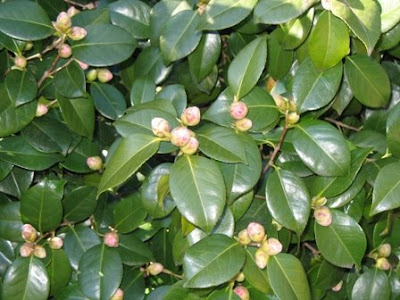
This is a follow-up to a
post I wrote back in January about the Holm Oak (Quercus Ilex) that I will refer to here by its Spanish name "La Encina". After having lived in Spain for almost ten years I have come to the conclusion that this is probably the second most common and important tree in Spain after the
Olive tree. The primary reason for its importance, as I mentioned in my earlier post, is that it is a source of acorns for the Iberian pig from which a number of very important meat products are made from. The image above is typical of the countryside in the region of Extremadura within the province of Cáceres. All of the trees in the picture are Encinas.

These images (above and below) are from a small Iberian pig farm. These pigs are fairly small and quite dark in color. Being allowed to forage over a fairly large area helps keep them lean. Before the Encina Oaks acorns are in season these pigs are fed melon rinds and various types of grains. When the acorns are in season that feed almost exclusively on the flavorful fruits of the Enicna Oak (the
Cork Oak,
English Oak and
Portuguese Oak are also sources of acorns for these pigs). The slaughter of these pigs for making Jamon Serrano (cured ham) and other meat products is in November-December right after the end of the acorn season.

The Jamon Serrano that is made for these black hoofed Iberian pigs is Spain´s most prized product. Some other meat products that are made from these pigs are Chorizo, Lomo and Paleta. The "Jamon Serrano" is the whole hind leg that has been carefully cured under special conditions in the same way that it been prepared for hundreds of years. The "Paleta" is the foreleg and is less valued (and thus cheaper).

The image below is of a rather large, three trunked, Encina Oak in Extremadura.

 Hidden in the most unexpected places of Extremadura (means "extremely hard or difficult), Spain there some extraordinary swimming holes like the one in the picture above. This swimming hole complete with a great rope swing is about 15 feet deep. But this post is not about the swimming hole itself but rather about the trees the hide it. Lined on both sides of the small river forming a dense green cover are a series of Common European Alder trees (Alnus glutinosa). These tree like water! So much so that if you swim in this water hole and want to get out you are required to use the tree roots that line the bank much like you would use the ladder in a swimming pool. The contour of this natural pool is part rock part tree roots.
Hidden in the most unexpected places of Extremadura (means "extremely hard or difficult), Spain there some extraordinary swimming holes like the one in the picture above. This swimming hole complete with a great rope swing is about 15 feet deep. But this post is not about the swimming hole itself but rather about the trees the hide it. Lined on both sides of the small river forming a dense green cover are a series of Common European Alder trees (Alnus glutinosa). These tree like water! So much so that if you swim in this water hole and want to get out you are required to use the tree roots that line the bank much like you would use the ladder in a swimming pool. The contour of this natural pool is part rock part tree roots. The fruits of the Common European Alder (sometimes called "Black Alder") look like miniature pine cones measuring about 5/8 of an inch long (1.3 cm). The trees have both seed (roundish) and pollen (long and thin) "cones" although I am most likely not using the correct terminology here.
The fruits of the Common European Alder (sometimes called "Black Alder") look like miniature pine cones measuring about 5/8 of an inch long (1.3 cm). The trees have both seed (roundish) and pollen (long and thin) "cones" although I am most likely not using the correct terminology here. The leaves are simple and round to almost heart shaped with pronounced veins and short stems. They also have a somewhat serrated margin as can be seen in the picture below.
The leaves are simple and round to almost heart shaped with pronounced veins and short stems. They also have a somewhat serrated margin as can be seen in the picture below. In the next image you can see the seed "cones" both when they are green and later when they are dried and open having released their seeds. The ones of the left illustrate the "cone" likeness.
In the next image you can see the seed "cones" both when they are green and later when they are dried and open having released their seeds. The ones of the left illustrate the "cone" likeness.

























